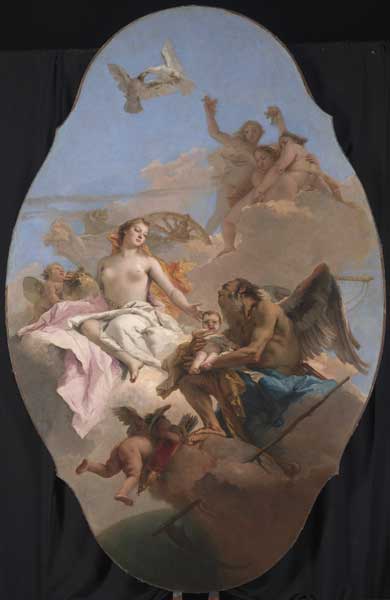Great Works: An Allegory with Venus and Time (c.1754-58), Giovanni Battista Tiepolo
National Gallery, London

Is it possible to sleep, tread, loll, lean and generally pontificate on clouds? That is one of the various unserious questions we often ask ourselves when we stare into some of the paintings of Giovanni Battista Tiepolo, that weightless prestidigitator of 18th-century Venetian art. Appreciating the art of Tiepolo is a little like being stuck inside one of those sealed spaces-between-spaces that exist between two locked doors at the entrances to city banks. You are neither in nor out. You exist, albeit temporarily (we hope), in an in-between world.
This is exactly our state of mind when we inhabit the painted world of Tiepolo in this painting. It feels like a world which exists outside the moral universe which we customarily inhabit. It lacks both gravity (we can see that at a glance, of course) and gravitas. It feels morally weightless, gorgeously fanciful, a lightsome, sumptuously decorated simulacrum of this serious world of good and evil. The Renaissance has been blown away, as if it were a dream.
Not all of his work is like this by any means, but it is a powerful strain. Its values are nothing but the seductive values of the lovely, painted surface. He is taking his commission to paint this ceiling of a private villa very seriously, but there is nothing except sheer play in the way that he is treating his theme. It is, in short, perfectly at one in spirit with Venice itself, that sometime great empire which, when this painting was being made, was in a condition of irretrievable decline, and would finally fall to the forces of Napoleon Bonaparte about 40 years after the work was finished. All it had left was its magnificently decadent surface sheen. And so it has remained, and Tiepolo still resides there, beguilingly magnificent, sharing a common mood with Longhi's closeted interiors of the prosperous at play, and Guardi's delightful architectural caprices.
First of all we admire the shape of this great picture, so uncustomary, so attention-grabbing. We can speculate that Tiepolo is following the shape of some 18th-century architect's decorative pattern book for a ceiling panel. This lovely series of broken curves is somewhat like an oval in its overall shape, but not exactly. It is also a little – just a little – like a stylised rendering of that floating, scalloped shell on which another Venus, Botticelli's this time, also floated towards us, except that she was borne up by waves rather than clouds. It reminds us of the shape of a lovely brooch or cameo on the handsome swell of a painted bosom; it enhances our conviction that what we have here is pure, decorative, eye-bogglingly self-conscious spectacle. Yes, that's what Tiepolo was, so often, an exquisite interior decorator, a man for all ceilings – like Michelangelo before him, who in fact snarled and grumbled about the fact that he had been commissioned to paint the Pope's ceiling for the Sistine Chapel because it was so lowly a task in comparison with his life's truly great work, which was the creation of deathless works of sculpture.
As we stare at it, we feel ourselves almost pitching dizzily backwards into empty air, mimicking the painting's own movement, which seems to fall backwards into the far blue depths of the sky as we look and look. He seems to be observing this assorted gathering of mythological beings, Venus, Cupid and Time, from so many dizzyingly different angles simultaneously. It is not merely a matter of determining a single point of view, and remaining steadfastly faithful to it like that fanatical Uccello once used to do. Venus, who is surly, aloof or simply icily indifferent – that face is very difficult to read – has handed over her pudgy son, an aged baby with a pronounced widow's peak, to Time, who looks a little like a sentimental pantomime sailor. How gorgeous are the fabrics which billow about her! A pearl-studded belt loosely laps her waist, very seductively, as if it were a sly male arm. Meanwhile, pudgy-buttocked Cupid climbs the air in company with his enormous quiver of arrows. His testicles are just peeking through, arrestingly. This baby is Aeneas who will become, in time, a hero of heroes. All that future is set aside for the space of this painting. Here he is nothing but a sulky, finger-sucking child suspended in crowded air.
ABOUT THE ARTIST
The brilliant, tirelessly productive Venetian painter Giovanni Battista Tiepolo was born in 1696 and died in 1770. His range of work was immense, and he travelled extensively in Europe. He painted murals, genre scenes, historical and religious works, and also found time to be an accomplished draughtsman and etcher. His paintings are celebrated for their lightness of touch, their airiness, their gorgeous blue skies, and he was celebrated for his great decorative schemes throughout Europe. He kept a busy workshop, and he was often assisted with his great murals by his less talented sons Domenico and Lorenzo.
Subscribe to Independent Premium to bookmark this article
Want to bookmark your favourite articles and stories to read or reference later? Start your Independent Premium subscription today.

Join our commenting forum
Join thought-provoking conversations, follow other Independent readers and see their replies